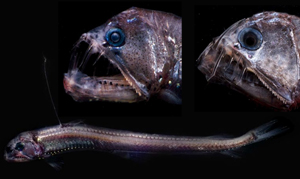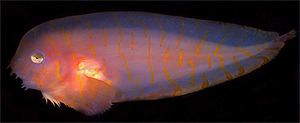Intro
In this section
- Learn about different zones in the ocean.
- Learn about the .
- Examine species as their bodies change to meet the demands of different environments at each stage of life.
- Explore how body types evolved as conditions on Earth changed over time.
Living in mostly separate worlds, immersed in different fluids - water vs. air, land vertebrates and fishes are equipped differently for life. Land vertebrates have lungs instead of gills, heavy skeletons to support their weight, and a greater attachment to their young than fishes. But for all their differences, the terrestrial vertebrates share many features in common with fishes - most importantly brains and jaws that fishes developed first.
Fishes exhibit an amazing range of physical capabilities, toleratating extreme environments, making a living where food is scarce and migrating great distances. A small Desert Pupfish withstands hot waters near-100° F while a bloodless icefish survives near-freezing temperatures. A male anglerfish attaches itself permanently to a female to conserve energy and to make sure a good mate doeson't get away. Salmon have no regrets about returning to the streams where where they hatched and where they will reproduce, even if it triggers the impending end of their lives.
Nighttime fishing no goodThe intertwined lives of all of the organisms that make up the web of life, and the habitats they require are full of fascinating stories when we look. Many of the strategies found in nature have application in our own survival. Many contain engineering designs and strategies to apply in our In this section, explore the variety of fishes and how their physiology make it possible. Learn how we've applied our knowledge of fishes to improve fishing practices and conserve species.
No one body design succeeds everywhere all of the time. The great variety of habitats and circumstances that have developed on Earth allow for the great variety of species that coexist today. Modern fishes are part of a long procession of fishes that began x years ago.
Join us in this first segment, Kinds of Fishes, for a whirlwind introduction to the great variety of fishes.



Target concepts for this section:
- The diversity of fishes is greater than you might have thought.
- Different species have different internal and external physiology.
- Physiological features, biochemical processes and behavior allow fishes to successfully reproduce, live under particular conditions, and coexist with particular competitors.
- Physiological features are derived by sequential modification of preexisting species characertistics that are inherited through genetic codes.
- Biodiversity is the result of evolutionary processes and the existence of a great variety of habitats.
- Loss or degradation of habitat and overfishing leads to loss of species.
- The modern rate of species loss is as high as ...
- Scientific knowledge about the biology and ecology of fishes allows us to make better species management decisions.
